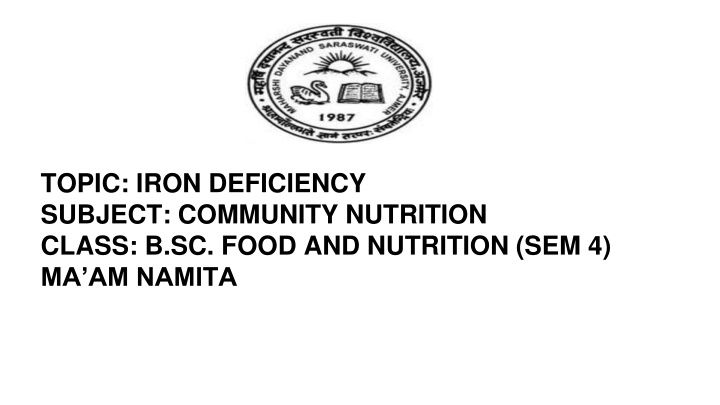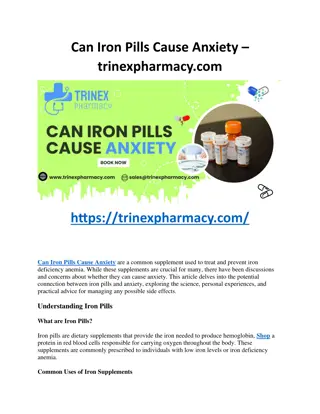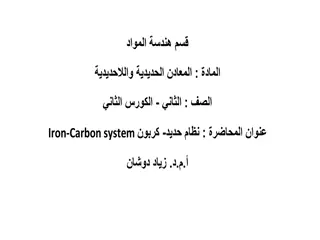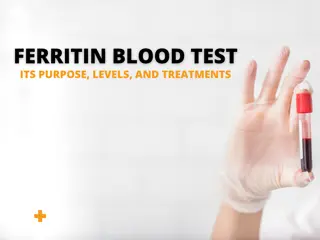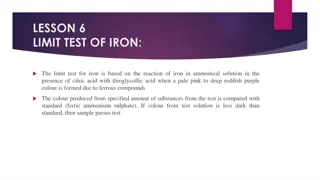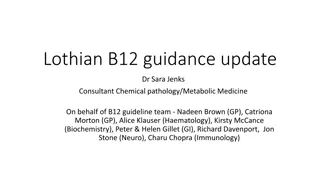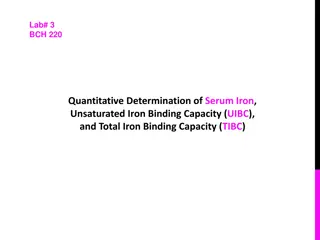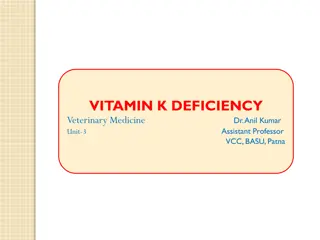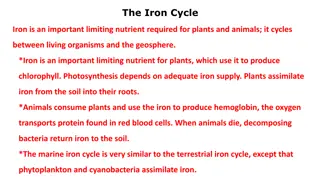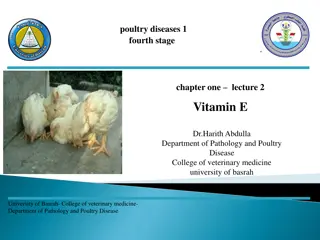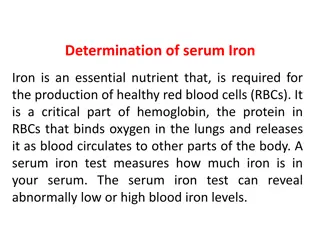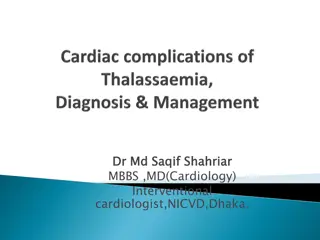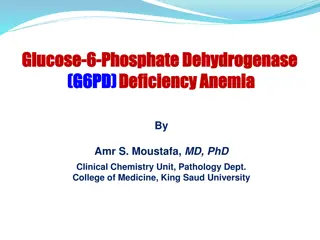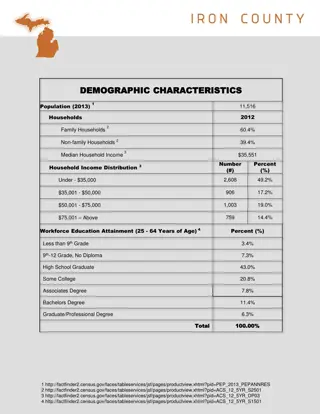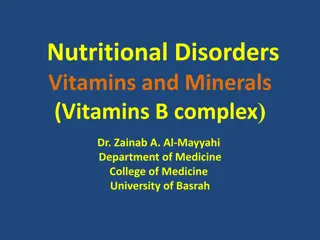Iron Deficiency: Prevalence, Symptoms, and Implications
Iron deficiency is a significant concern in India, particularly affecting children, pregnant women, and older adults. The prevalence varies across demographics, with notable impacts on health and well-being. Recognizing the signs and symptoms of iron deficiency is crucial for early intervention and proper management to prevent long-term complications.
Download Presentation

Please find below an Image/Link to download the presentation.
The content on the website is provided AS IS for your information and personal use only. It may not be sold, licensed, or shared on other websites without obtaining consent from the author.If you encounter any issues during the download, it is possible that the publisher has removed the file from their server.
You are allowed to download the files provided on this website for personal or commercial use, subject to the condition that they are used lawfully. All files are the property of their respective owners.
The content on the website is provided AS IS for your information and personal use only. It may not be sold, licensed, or shared on other websites without obtaining consent from the author.
E N D
Presentation Transcript
TOPIC: IRON DEFICIENCY SUBJECT: COMMUNITY NUTRITION CLASS: B.SC. FOOD AND NUTRITION (SEM 4) MA AM NAMITA
Prevalence of Iron Deficiency Children in india varies from 35-45% in various studies Higher in female. More in case of pregnancy with the prevalence rate of 45-60% Prevalence in both rural and urban area. Severity is high in lower socioeconomic groups. High risk to children, adolescents girls ,pregnant females. lactating mothers mainly in rural areas and old age people.
Signs And Symptoms # Three Stages of Iron Deficiency a.First stage is characterized by decreased storage of iron without any other detectable abnormalities. b An intermediate stage of latent iron deficiency, iron stores are exhausted but no anemia.The percentage saturation of trans ferrin falls from a normal value of 30%to less than 15%. c. the third stage is over iron deficiency where there is decreased in circulatory haemoglobin.
Clinical Symptoms 1. Immunocompetence: A sign of early iron deficiency,particularly defects in cell mediated immunity and phagocytic activity of neutrophils. Increased incidence of candidiasis ,upper respiratory infections. 2. Diminished Work Performance: Easy fatigue and decreased work Performance because iron deficiency affects muscle function. 3. Cognitive Development: Early deficiency leads to irreparable damage. in young adolescents leads to poor academic performance also affects attention span and learning abilities.
4. Behavioral Implications: Anemic person show more disruptive, irritable and restless nature due to functional changes in iron enzymes at cellular level. 5. Structural and Function of Skin and Epithelial Tissue: Premature loss of hair, alopecia, greying of nails are some symptoms of iron deficiency with or without anemia. # Fingers nails can become thin and flat and development of koilonychia (spoon nail) # The skin appear pale and the inside of the lower eyelid becomes light pink instead of red.
# Mouth changes include atrophy of the lingual papillae, burning redness in severe cases and also a completely smooth waxy and glistening appearance to the tongue. # Gastritis occurs frequently and may result in achloryhydria (absence of hcl acid in gastric secretion.) # Progressive untreated anemia results in CVD and respiratory changes and may also leads to cardic failure. The general symptoms of long term deficiency are lassitude, fatigue, dizziness, breathlessness, palpitations, paraesthesia in fingers and toes and growth abnormalities.
Nonhaematological Signs And Symptoms Oxygen transport and cellular respiration: Iron is an important component of several respiratory proteins and respiratory enzymes so deficiency of iron cause defective electrons transport and cellular respiration. Several mitochondrial proteins within the cells including cytochromes contain iron and these are both haeme and non heame iron sulphar complexes. Several ot the citric acid cycle enzymes like aconitase, succinate dehydrogenase, isocitrate dehydrogenase require iron for enzyme activity.
Porphyrin Metabolism : Uroporphyrinogen require iron for their synthesis. In absence of iron cellular respiration affected ,cell may not be able to reproduce or divide as these needs energy and energy derived fron cellular respiration and cells may die by apoptosis. Pigment Metabolism: Iron is required for the synthesis of enzymes phenylalanine hydroxylase, homogentistic oxidase, these enzymes help in formation of melanin quinones. Iron deficiency can affect the formation of melanin pigment.
Monoamine MetaMetabolism: Cateccholamine is one of the most important monoamines involved in adrenergic neuro transmission. iron has been found to be important component of neuronal monoamine oxidase. DNA and RNA Metabolism: Ribonucleotide reductase is required for converting ribonucleotide to deoxyribonucleotide ,in the absence of iron this reaction is not possible. Cytochrome P450 and drugs metabolising enzymes: Heame iron as essential component of the enzymes are involved in phase 1 reaction in bio transformation of drugs and other xenobiotics.
Treatment Oral administration of inorganic iron in the ferrous form, ferrous sulphate 50-200 mg (60 mg of elemental iron) 3 times daily for adults and 6 mg/kg for children. degree degree are ferrous form of lac lactate,fumarate,glycine,sulphate sulphate,glutamate and glu-co conate. Others salts absorb at same
Iron is best absorbed when the stomach is empty. It may cause gastric irritation, nausea, vomiting, epigastric discomfort,distention,heart burn,diarrhoea or constipation. Can minimize by increasing the dose slowly over a few days until the required dosage is reached and by giving iron in divided doses at least 3 times per day. Use of chelated form of iron can result improved absorption and can reduce the gastrointestinal stress. Ascorbic acid greatly increases iron absorption through its capacity to maintain iron in reduced state.
